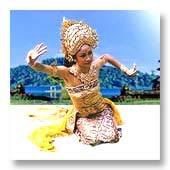The Bali Arts Festival is a full month of daily performances, handicraft exhibitions and other related cultural and commercial activities during which literally the whole of Bali comes to the city to present its offerings of dance, music and beauty. On display are trances from remote mountain slopes, forgotten or recently revived village dances, food and offering contests, classical palace dances, stars of Balinese stage, odd musical performances, "kreasi baru" (new creations) from the dance schools of Denpasar, as well as contemporary choreography and dance companies from other islands and from abroad.
It is a month long revelry that perhaps no other place in the world can put up on such a low budget as the Balinese. Not only is their traditional culture alive and well, but they have a tremendous pride in it.
It begins in the villages, where the seka or cultural groups are selected and organized at the regency level, vie with each other to perform the Arts Festival and thus display in front of a large audience the uniqueness of their village of birth and resting place of their ancestors.
The Bali Arts Festival is the Denpasar cultural event of the year, perhaps it would no be too far fetched to suggest that it is the cultural event of Indonesia. The festival is thus a unique opportunity to see local village culture both "live" and at first hand. Tourists are warmly welcomed.
The History of the Bali Arts Festival
When tourism took off after 1965, the Balinese insisted that it followed cultural guidelines: if tourism was to be accepted, it was to be a cultural tourism, or "pariwisata budaya".
As the Balinese put it: "Tourism should be for Bali instead of Bali for tourism." In time, this idea become national policy, as part of a larger revping of regional cultures for national purposes. The policy owes much to the former Director General of Culture (1968-1978) and Governor of Bali (1978-1988), Ida Bagus Mantra, an Indian-educed Balinese. It led, on the one side, to the creation of enclave resorts such as Nusa Dua to limit the direct impact of tourism, and on the other, to a long haul cultural policy aimed at nurturing and preserving the traditional agrarian culture while adapting it to the demands of modernity, and in particular of "cultural tourism".
At the village level, local music groups, dances and other cultural events were inventoried, then supported by a series of contests at the district and regency level. The ensuing competition energized the cultural life of villages, whose "young blood" was already being drained to the city by the process of economic change and urbanization.
Schools of dance and art were created, in particular the Kokar conservatory and the STSI School of Dance and Music. Beside research, these schools replaced the traditional master/disciple relationship by modern methods of teaching; standardized the dance movements, produced new types of Balinese dances for tourism and modern village entertainment. Most important, it enabled former students to return to the villages as teachers, where they diffused, beside the creed of cultural resilience and renewal, new dances and standardized versions of old ones.
Many of the performances are held at the amphitheater which can hold up to 6,000 spectators, in a temple-like stage.
Each year, the Bali Arts Festival, beside the fed classical dances of the island, such as the legong, gambuh, kecak, barong, baris, mask dances and the like, is based on the theme around which new "dance choreography" is produced and old village dances and activities revived. Over the years, the whole range of classical Balinese stories - Ramayana, Mahabharata, Sutasoma, Panji - have thus been turned into "colossal" Sendratari Ballets.
The main challenge to the Arts Festival is obviously economic in nature. As village life is increasingly feeling the strains of monetary considerations, dancers, musicians and others cannot be expected to continue participating simply for the sake and the pleasure of it. As costs soar, new sources of financing have to be found. The obvious answer is the private sector and in particular the tourism industry. The greater task then is to convince the hotels, travel agencies and tourist guides to be more participatory in the Arts Festival rather than to their own sponsored events.
Considering the pride the Balinese have in their culture, and the adaptability and dynism they have always demonstrated, this little hurdle can be overcome. Trust the Balinese. They will eventually succeed to transform their tradition into a modern, Balinese culture of their own.












